The Tree of Life in Bahrain
The Tree of Life in Bahrain
An extremely original, one-of-a-kind tourist attraction of Bahrain is the world-famous ‘Tree of Life’. Despite many scientific studies scientists are still unable to clearly answer where this lonely tree located in the oil fields in the desert draws life from. Well, I have my theory too. . . . .
The Tree of Life – why shall we bother with it at all?
My question to travellers: how many people would take the trouble of traveling through a hot desert, among oil fields with ‘volcanoes of fire’ to see one tree? Well, that was me because I found that unique peculiarity of nature worth knowing and describing. I never expected before to write an article about a tree in a dry desert. This article however is not only about nature but also about philosophy, scientific opinions and folk beliefs. You are welcome to read.
“There’s nothing wrong with having a tree as a friend”
Bob Ross
The Tree of Life (Shajarat-al-Hayat) in Bahrain is about 500 years old, is of the Prosopis cineraria species and it is almost 10 m tall. It grows on a sandy hill over 7.5 m high. The Tree of Life grows in the oil fields of Bahrai in the Arabian desert, 2km from Jebel Dukhan which is the highest point in Bahrain. The Tree of Life is about 40 km from Manama.
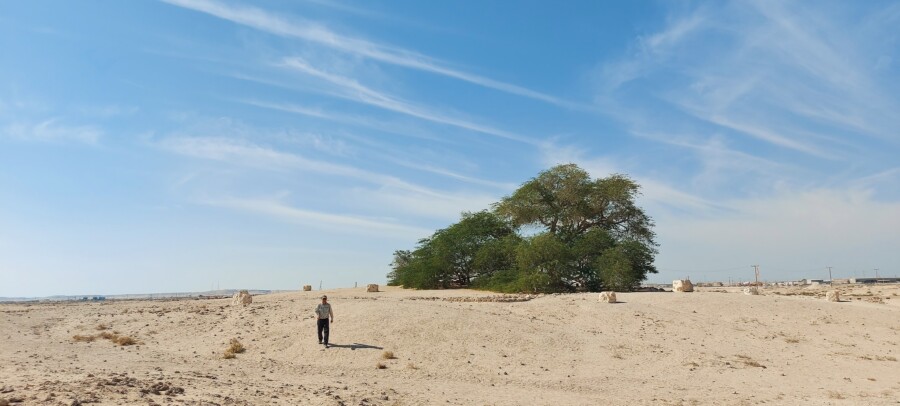
My desert adventure in the oil fields of Bahrain and the Tree of Life.
The Tree of Life has been the object of research by scientists since time immemorial, because even with current technology many answers deserve only the name of a more or less probable hypothesis. For example in the 1990s, after analyzing the soil and dendrochronology, scientists concluded that the Tree of Life in Bahrain is an acacia tree planted in 1582. In 2010 scientists discovered pottery and many other artifacts around the Tree of Life dating back around 500 years. They concluded that the Tree of Life was built near a 500-year-old military fortress.
When I got there I really found the solitary location of a tree in a hot and inhospitable desert to be an interesting object. I also liked its extensive thick branches supported by wooden logs, and the fact that this tree is abundantly covered with fresh green leaves and it looks healthy. It is the only large plant for miles around and it looks good on a desert hill. These are all great assets of this tree, but the most interesting question is where it gets its life from. 92% of Bahrain is covered by a hot desert and there isn’t any source of water anywhere near the Tree of Life, which could give life to this mystical tree. Still however, when looking at its over 500-year history and fresh green leaves, it is obvious that a tree growing in such a hostile terrain is still blooming.
“A tree with strong roots laughs at storms”
– Malay proverb
In this part I wanted to explain why this tree is so fascinating and why it is worth to be interested in it. In a poetic sense the Tree of Life in Bahrain is regarded by many as a symbol of hope because it is able to survive even in the most hostile and life-defying conditions. Because this tree has overcome such difficult adversity and it blooms in the middle of the desert, it has become a symbol of hope. In my opinion, the history of this tree teaches people to never give up and always fight, no matter how much adversity they encounter. It is not surprising then that the Tree of Life has become a local tourist attraction and is visited annually by approximately 65,000 tourists from around the world. I believe that due to its history, age, picturesque location and the element of adventure and mysticism, it deserves attention.

Tree of Life, Bahrain.
What species of tree is the ‘Tree of Life’
I am not a botanist and I;m not writing this article for botany students, that’s why I;ll try to summarize this section as simply as possible. Well, the genus Prosopis is a species of flowering tree in the pea family Fabaceae and is known for its adaptation to living in arid and semi-arid areas of America (mainly South), Africa and Asia. The Prosopis family includes 44 species of trees and shrubs. As many as 40 of them come from South America, where it even has its local name: mesquite; and the greatest variety of these trees is found in Argentina, with as many as 27 species. One species of Prosobis comes from Africa and three from Asia.
A very important feature of the Prosobis species are the deep and extensive root systems that allow them to access water deep in the ground. Sometimes these systems are as deep as 8m, although scientists estimate that they can be much deeper. It is also important that the Prosobis species has high tolerance to salinity because those trees are found at the bottom of valleys where water flows down and evaporates, thus concentrating salts in those places.
Previously it was assumed that all species of Prosobis came from South America, therefore a popular and also sensible thesis of the origin of the Tree of Life was that it was planted by Portuguese merchants. Bahrain was a colony of Portugal in the years 1559-1602 and today the evidence of this colonization is for example Fort Bahrain built by the Portuguese. The Portuguese colonized a large part of South America, of which Brazil was their biggest conquest. However, this theory lost ground when it was discovered that a subspecies of this tree, Prosopis cineraria, originated not from America but from vast, arid parts of Western Asia, the Indian Subcontinent, Afghanistan, Iran and the Arabian Peninsula (including Bahrain).
“Trees give peace to human souls”
– Nora Waln
Besides, the Prosopis cineraria tree is widely used in traditional medicine to treat many diseases such as: leprosy, asthma, leucoderma, dysentery, indigestion and earache. The bark is used as wood, for tanning, for firewood and charcoal. It is therefore a very useful tree that has adapted well to extremely hostile conditions and that’s why it should be important for people.
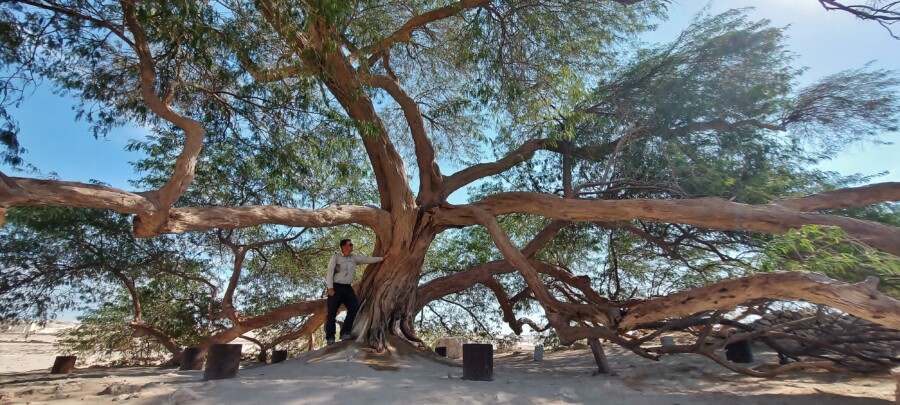
The Tree of Life and its vast branches. Bahrain.
Where does the Tree of Life draw its life from?
Throughout history there have been many theories about how the Tree of Life is able to survive in the desert. Some of them are scientific theories and others are based on religious and folk beliefs, what only proves how much this place fascinates people from many social groups and many countries of the world. I will refer to both theories and also present my opinion.
Tree of Life – scientific theories
In my opinion the mysteriousness and mysticism of survival of a lonely tree in the desert are perhaps a bit exaggerated, although I understand that it’s a very good way of advertising, especially since it is indeed a magnificent tree in picturesque desert landscape. In the section above on the Prosobis tree species I wrote that it is characterized by extensive root systems that are at least 8m deep, although they can be much deeper.
The Prosobis tree in Bahrain is about 400 years old and that’s why many scientists speculate that its roots can reach up to 50m deep, where they draw life from groundwater. Other scientists disagree with this theory and claim that the nearest source of water is an underground stream at least 2 km away. However in my opinion, did the same scientists dig a pit under the sand 50m deep near the tree? Some scientists guess that the Tree of Life draws its water from the sea breeze from the Persian Gulf. In my description of the Prosobis tree species I also provided information that this plant has a high tolerance to salinity. In my opinion this may be a truth of dubious quality but it is not a decisive factor; especially in such a hot climate and with an annual rainfall of about 170mm. That’s why I consider underground waters, which to some extent may also be saline, to be more likely. Additionally, scientists believe that the tree’s ‘complex leaves’ i.e. leaves with lots of tiny leaves growing on the main leaves, also help to keep the tree cool. Another theory advocates that the tree gets its water from fungi growing in the soil.
“If olive trees knew the hands that planted them, their oil would become tears”
– Mahmoud Darvish
I also looked at the possibility of drawing life through the bark of a tree, which nature still amazes people. Even though an animal or a plant will do anything to survive, I find the following method not decision but slightly helpful in survival. Well, has the Tree of Life learned to ‘get water out of grains of sand’? Interesting, right? Well, I think that first we should ask ourselves if there is life in dry sand. Of course not, but under certain atmospheric conditions it can also be a source of water.
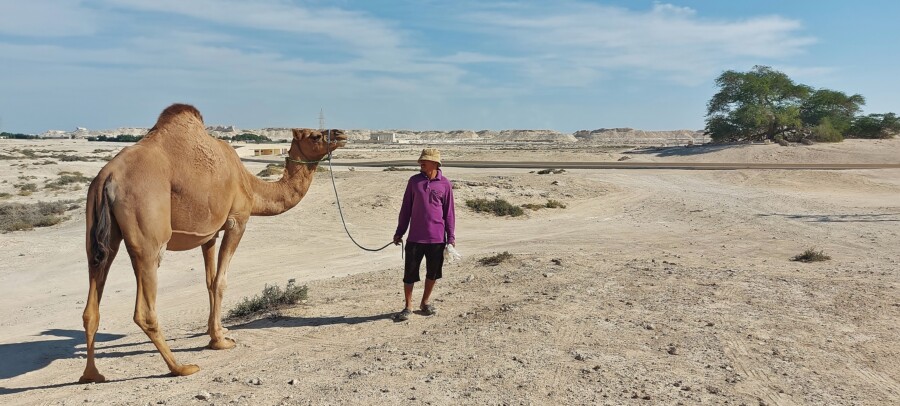
Walking with a camel in the desert. In the background Tree of Life, Bahrain.
For example, the Australian Thorny Devil stays hydrated thanks to its skin, which draws water from the moist grains into its mouth. Let’s imagine that in the Australian desert it hasn’t rained for weeks and there is no water tank, but a small lizard effortlessly takes water because it’s also able to take it through its skin and feet. Between the scary spikes on the thorny devil’s skin there is a network of microscopic grooves that absorb water through its skin and which also flows into its mouth. In addition, this lizard can bury itself in cooler sand, where water also accumulates under its belly. Later it then flips the damp sand onto its back and absorbs the moisture through the skin.
Rattlesnakes have been observed curling up tightly in light rain to drink the water which accumulates between their coils. Animals have their own ways of surviving in very harsh conditions, though I doubt morning dew and natural condensation would be enough to survive. However, this does not change the fact that these fascinating reptiles, like the Tree of Life, are able to survive in the hot desert. When examining the area around the Tree of Life I saw a lot of small plants within a kilometer, even one tiny tree, and moist depressions in the soil. Desert plants have long roots that help them to absorb water, while morning dew or sea breeze from several kilometers are the additional rewards of nature. The Tree of Life is huge, majestic and impressive, although there are many small plants in that Bahrain oil field. In addition that tree grows about 10-12 m above the sea level and the groundwater level in that place is higher than the sea level.
Tree of Life – folk and religious theories
I include this subchapter as a curiosity because I think it’s worth knowing how the term ‘Tree of Life’ is understood in different cultures. It turns out that on this matter all cultures from different civilizations speak a very similar language. When referring to the Tree of Life all cultures talk about peace, harmony, wisdom and new life. I’m not able cover all the cultural aspects but I think it’s not surprising that none of these theories have been confirmed or denied.
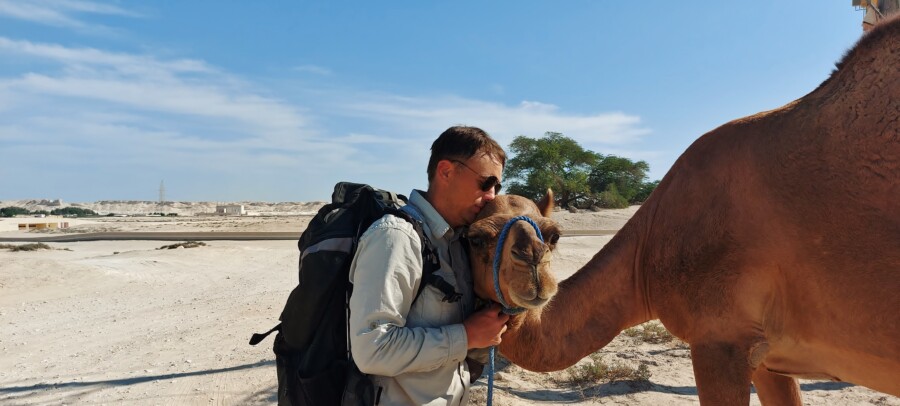
I am capable of love after all. In the background is the Tree of Life in Bahrain’s oil fields.
Referring to Christianity, the Tree of Life in Bahrain was once part of the biblical Garden of Eden. In the Bibl the Garden of Eden is described as having its own Tree of Life which is the acacia, a tree similar to Prosopis which thrives in a desert environment. For that reason there is an opinion that this tree grows by some mystical blessing. In the Bible the Tree of Life was the tree of eternity and a symbol of God’s wisdom and love.
Koran also has the theme of the Tree of Life, which is the ‘tree of immortality’, and in Islam this theme is found in several religious books. There were many trees in the Garden of Eden in the Bible, but according to the Koran there is only one tree which was whispered to Adam by Satan as the ‘tree of immortality’ and which Allah forbade to eat from. In the Bibl the ‘Tree of Life’ is also presented as ‘the tree of wisdom’, while in the Koran the tree represents the way of life and the code of life. The tree in Islam therefore represents an idea but in a figurative form, referring to good and evil. A good tree represents a good idea and a good code of life, while a bad tree represents a bad idea and a bad way of living.
I can see that on this point the Koran and the Bible speak the same language, referring to good and evil in the sense of knowing people by their deeds:
“Beware of false prophets, who come to you in sheep’s clothing but inwardly are ravenous wolves. You will know them by their fruits. Are grapes gathered from thorns, or figs from thistles? So, every sound tree bears good fruit, but the bad tree bears evil fruit. A sound tree cannot bear evil fruit, nor can a bad tree bear good fruit. Every tree that does not bear good fruit is cut down and thrown into the fire. Thus you will know them by their fruits.”
Matthew 7: 15-20
In Jewish culture the Tree of Life is commonly known as Etz Chaim, which in Hebrew means ‘tree of life’ or ‘tree of souls’. That tree blooms and produces new souls which then fall into the vault of souls. This name is associated by initiated Jews with peace and wisdom, and it is the name of the Tree of Life which bear the name of religious schools and synagogues.
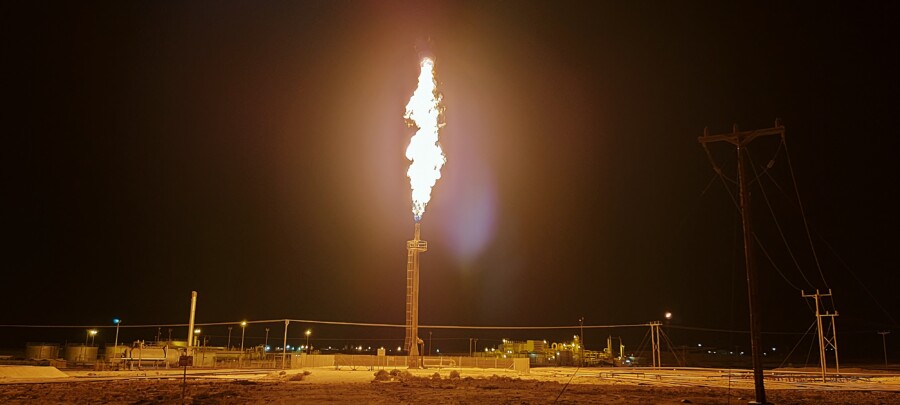
‘Volcano of Eternal Fire’ in Bahrain’s oil fields. Walking through the desert at night, I passed oil wells.
According to the Babylonian and Sumerian religions the Tree of Life is protected by the water god Enki. Ancient Egypt on the other hand treated the Tree of Life as a representation of the series of events that brought everything into existence. The tree on the other hand consists of various stages that represent the creation process step by step. In Egypt the sacred tree was the evergreen date palm and the palm branch was a symbol of the god Heh, who was the personification of eternity. According to the same civilization of ancient Egypt the branches of a tree reaching towards the sky represented abundance, while the roots reaching deep into the earth represented death.
While in Sri Lanka and Thailand I was under the sacred Bodhi tree, sometimes also called Mahabodhi. In Buddhism the Tree of Life is also the ‘tree of awakening’ because Buddha achieved enlightenment under the sacred Bodhi tree. In Buddhism the tree is a symbol of enlightenment and existence. In Tibet, famous for Buddhism I also saw tree motifs.
I saw exactly the same thing in India. In the state of Bihar, in Bodh Gaya there is a ‘tree of enlightenment’ called the sacred Mahabodhi tree. According to the Buddhist beliefs Siddharta attained enlightenment under this tree around 500 years before Christ, and as a result he became Buddha. In India however it is not an acacia but a fig tree.
“Searching for the Tree of Truth in a world of Illusions. . . the only reliable compass is your own soul”
– Enza Currenti
The culture of the Celts is also interesting, according to which trees represented their ancestors, deities, the afterlife, guardians on the way to the afterlife, and they also represented connection between earth and heaven. For the Celts trees were of great importance and therefore were sacred.
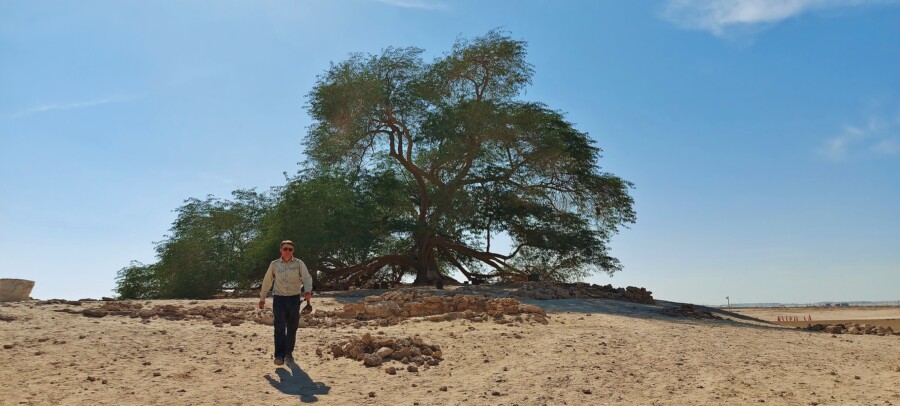
Bahrain. Tree of Life.
Clearly, the cedar tree has a very special place in Lebanese culture. The cedar tree is the emblem of Lebanon and is on the Lebanese flag but it is also a symbol of resilience, strength and eternal life. The entire Lebanese nation identifies with the cedar tree, and the Bible mentions that:
“The righteous shall flourish like the palm tree, he shall grow like a cedar in Lebanon” (Psalm 92:12)
In Madagascar, where I also intend to go someday, the tree representing life is the symbol of the ‘island of lemurs’ – the Baoab tree. Baoab is exceptionally beautiful, tall, wide at the base, narrow at the top and with a flat crown. I have already seen baoabs in the Sultanate of Brunei because the sultan brought them from Madagascar and ordered them to be planted in Bandar Seri Begawan. But back to Madagascar, the baoab is sacred because it bears fruit despite the hot, dry climate. Baoab is therefore revered as the giver of life and food in harsh climatic conditions.
At the end of my lecture on the perception of trees in different cultures I think the question should be asked if trees represent God? Yes, but not only that. All cultures regard trees as a divine gift which power passes through trees and eating its fruit means being close to God and consuming his presence and force of life. Also, a tree is not only an element of nature. Besides, trees represent family, new birth, strength, spiritual connection, peace and development. In some cultures trees also represent wisdom, immortality, and connection to ancestors living in the afterlife.
In my opinion a tree should also symbolize change, because trees change with the seasons, just as people change with passing time. However, this is not a bad thing because as time passes, people have new ideas and new opportunities. Just like trees, humans also go through the spring and autumn of their lives.
It is in this moment of philosophical reflection that we are moving on to a tree as a symbol of wisdom. . . . .
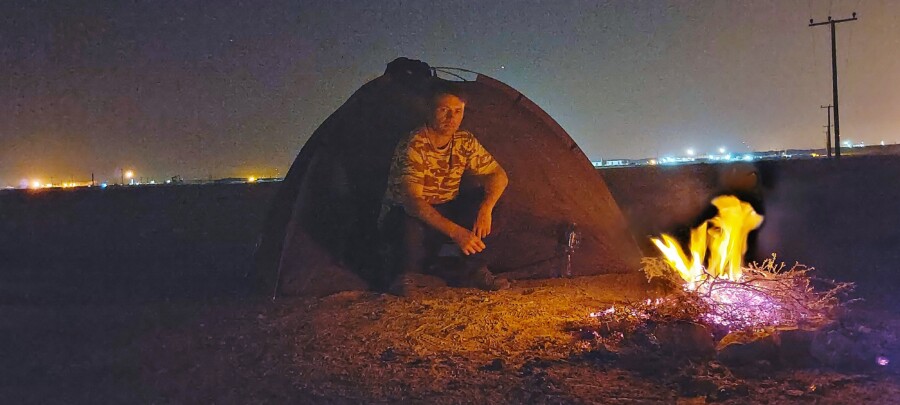
Another hard, cold night in the desert. Bahrain. (Most of this expedition was like a crash landing in a hot wasteland. The Arabian Peninsula doesn’t pamper ambitious lonely travelers, but it sure does offer plenty of adventure.)
My trip to the Tree of Life in Bahrain
I knew that I would be in this unique place probably only once in my life, that’s why I wanted to turn this experience into a real adventure. I got there in an interesting but poor style. Whilst walking along the road I managed to stop a car. The friendly Arab driver was so interested in my travels that although he was supposed to give me a ride only a few kilometers, he took me to the Tree of Life itself. We drove an off-road car through the desert but interestingly also through oil fields. I saw wide pipes on the surface, oil wells and of course, and what I call the ‘eternal oil fire’. It is a symbol of oil extraction because where there are shafts there is also a fire high above the ground.
Of course I took a good look at the tree, I read about it and walked around the area a few times. There are also organized trips to the Tree of Life, so those during which tourists get off for a short time, touch the tree, briefly look around the desert and return to Manama. But that is not my style. I pitched my tent, started a fire and spent that night in the cold desert. It was hard, cold and uncomfortable but I had to endure it. It is never easy in the desert because there are big temperature fluctuations. At night it was quite warm when the fire was still burning but when it went out it was cold, and hot again in the morning because the sun rose up.
(For example in the Sahara the temperature during the day easily reaches 50ºC, while at night it drops to -4ºC. I know that someone who has never lived in a desert, who hasn’t crossed it and has not experienced its hardship is not aware of that reality and may think that Martin Malik exaggerates because he is soft. My travels are far from being luxurious.)
Many times I had contact with the tree and walked further in order to get to know the desert, its nature and rock formations. The next day I folded my tent, put my rucksack on my back and walked across the desert. Along the way I passed through oil wells, ‘eternal fire volcanoes’ and pipelines. On one hand I enjoyed the view of the desert and exotic oil fields, I was glad that I fulfilled my plan, but I was tired. I just hoped I wouldn’t have fallen on my face because no one would have found me there. Soon I stopped the first car and said goodbye to the Tree of Life.
“People without knowledge of their history, origin and culture are like a tree without roots”
Marcus Garvey

The Tree of Life in various cultures, sometimes also called: ‘the tree of eternity, wisdom and immortality’. From the left: Christianity, Islam, Buddhism, and the Tree of Life in the Celtic culture representing among things harmony and balance in nature.



































